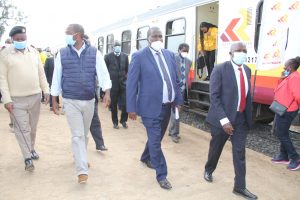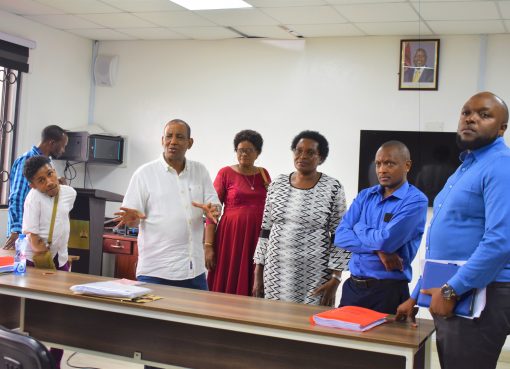

The revival of the 240-Kilometre Nairobi-Nanyuki metre-gauge railway line is now complete and has started operations by transporting petroleum products to the Shell Vivo Energy depot in Nanyuki town.
The Mining and Petroleum Cabinet Secretary (CS), John Munyes who toured the petroleum facility on Wednesday accompanied by a government delegation that rode the passenger train from Thika station to Nanyuki on a test run said the revival would offer a safer way of transporting petroleum products to Mt. Kenya region and Northern parts of the country.
“What this brings as far as the petroleum sector is concerned is efficiency, the security of our products is going to be achieved with this railway, it’s going to be cheap, safe because we are taking away trucks off our roads,” Munyes said.
The CS added that the transportation of petroleum via the railway will greatly minimise cases of fuel adulteration often common when the same is transported by trucks on roads.
“We have had cases of neighbouring countries complaining that fuel transported there through Kenyan roads is adulterated, but if we can restrict ourselves to transporting fuel via pipeline or railway, it means security of our products is achieved,” the CS said.
Munyes who was accompanied by the Principal Secretaries, Andrew Kamau (Petroleum) and Kirimi Kaberia
(Mining), termed the revival of the railway line a great milestone that would not only boost the agricultural potential of Mt Kenya but added the mining sector was likewise set to reap big as the train can be used to ferry bulk mineral deposits to processors easily.
“Mining and Railways go hand in hand, iron ore and manganese that have recently been discovered in this region will be easily exploited and transported by use of this railway the same way the petroleum sector is set to benefit,” he added.
The CS further revealed that revival of the railway came at a cost of Sh.1.8 billion provided by The Kenya Pipeline Company and that there were plans to extend the railway line to Meru and Isiolo Counties in order to connect it to the Lamu Port, South Sudan, Ethiopia Transport Corridor (LAPSSET).
Governor Ndiritu Muriithi who accompanied the CS on the train ride to Nanyuki said that the revival of the railway that cuts across the five Counties of Kiambu, Murang’a, Kirinyaga, Nyeri, and Laikipia that form part of the Central Region Economic Block would greatly boost the region’s economy that currently stands at Sh.2.7 trillion (27 billion USD).
“This is a fantastic investment in this region for us to be able to increase the efficiency of our logistics for our people,” Governo Muriithi said.
The Shell Vivo Energy Managing Director, Peter Murungi said that the 12 Million litre fuel depot would be converted into a common user facility whereby it can be used by any oil company to supply fuel to their dealers.
Murungi added that demand for petroleum products in Mt. Kenya was high currently standing at 4.4 million tonnes annually and with the coming of the railway, it means a huge turnaround with the efficiency of this facility to cope with increased demand.
“When we started we were doing trucks that have limited capacity and have to move in a very congested road network. Imagine that one rail tanker pulls an equivalent fuel of two trucks and in the safest way you can do beyond the pipeline,” the Vivo Energy MD said.
By Martin Munyi





